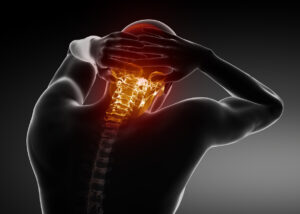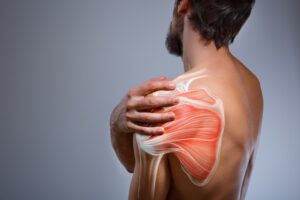When to Use Wedges in Cycling Shoes – Toronto Bike Fits
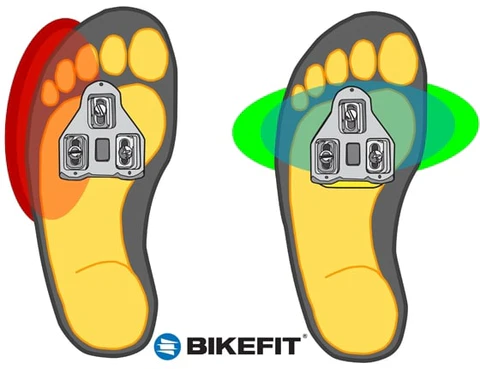
Knowing when to use wedges in cycling shoes is an important part of any bike fit. Some cyclings might require varus or valgus forefoot wedges in cycling shoes to optimize performance and minimize the risk of injury. In this comprehensive guide about using wedges in cycling shoes, we’ll delve into the crucial considerations of when to use wedges in cycling shoes, when to use them in a custom cycling insole and when to use a shim instead.
The most important thing to remember when reading this blog is that the choice to use a forefoot varus or valgus wedge in cycling shoes should always be based on a thorough biomechanical assessment. If you are looking for more information about custom cycling insoles or the best bike fit in Toronto read more about our process here.
The Role of Wedges In Cycling: A Through Assessment
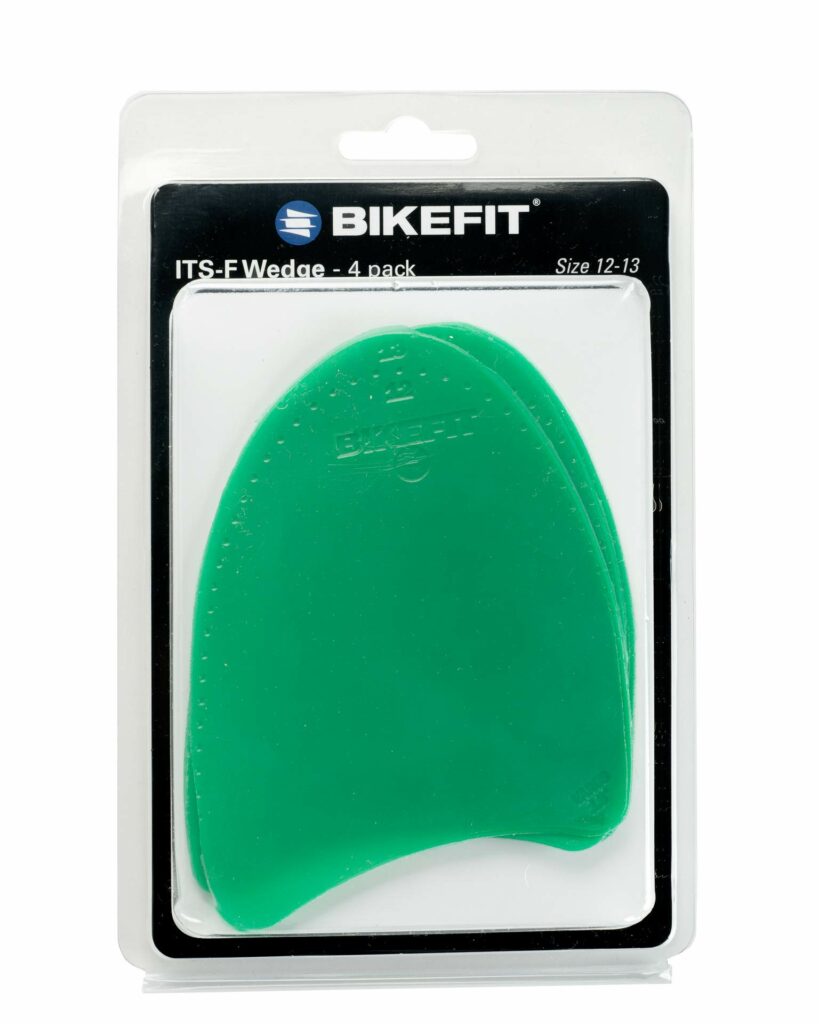
Wedges, particularly forefoot wedges, serve as essential tools for addressing biomechanical imbalances within cycling shoes. By optimizing foot alignment, these wedges can significantly impact comfort, power, and overall efficiency during rides.
The purpose of a forefoot wedge is to account for any rotation in the foot or occasionally to address flattening on an arch or pronation at the ankle. This is when to use wedges in cycling shoes – not for leg length inequalities (a shim)
A bike fit is often only as good as the biomechanical assessment on which it is based. As a Corrective Chiropractor, this is my differentiating factor: I perform a thorough and clinical-level assessment before every fit that helps us understand how to meld a client’s goals and function/structure. A comprehensive assessment of the lower limb including the biomechanics of the foot and ankle on and off the bike MUST be part of such an assessment to provide the most customized bike fit.
If your bike fitter is not assessing your body thoroughly then there they are just guessing as to when to use wedges in cycling shoes as part of their fit.
Neutral foot, Forefoot Varus or Forefoot Valgus: Getting the perfect fitting cycling shoes

Forefoot wedges should primarily be used to help form a neutral or flat interface between the foot and the pedal. We want the ball of the foot to be overtop of and flat over the middle of the pedal. This helps to optimize force transfer, comfort (eliminate hot spots) and minimal inward/outward stress on the knee.
In cases of forefoot varus, where the big toe is angled upward with respect to the heel or forefoot valgus, where the baby toe is elevated with respect to the heel, there will be a physical gap in the shoe between the elevated toes and the footbed.
In the case of forefoot varus, the unsupported inner toes will often drop down towards the footbed causing inward rotation of the leg and knee in the process. This can place valgus repetitive stress on the inner knee and eventually an injury if this stress is significant enough.
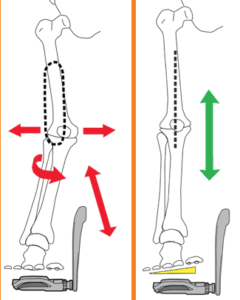
When I assess a bike-fit client that has forefoot varus, a forefoot varus wedge can be used to add volume and more support under the inner and big toes to reduce this downward collapse of the forefoot and potential stress on the inner knee.
I am one of the very rare people that has a small degree of forefoot valgus and I use a 1.5-degree valgus wedge to fill in the space between the footbed and the elevated outer toes.
When Not To Use Wedges Cycling Shoes
I would never rarely use a forefoot varus or valgus wedge in the following cases:
- Adjust for stance width. I have seen other bike fitters in Toronto accommodate for a wide stance width by placing wedges or shims under the inner foot (varus wedge) to account for the out-to-in pedal stroke adopted by a cyclist when their cleats are too narrow compared to their hips
- The solution, in this case, is to shave down the cleat washers to allow for more lateral travel of the cleat, use larger washers in the crank/pedal spindle interwave or buy pedal extenders
- Length length inequality. If necessary use a shim between the cleat and shoe as the wedges will reduce the volume in the forefoot of the shoe – potentially leading to pain and numbness issues
- Without confirming someone has forefoot varus or valgus. There should likely be a change in cleat position, shoe choice or saddle position to achieve the desired effect as the wedge(s) is not being used for its specific purpose in this case

Why To Consider Using Wedges:
- Foot Pronation Correction: Wedges can be used to address issues related to foot pronation. Excessive inward rolling during cycling can be counteracted with the strategic placement of wedges, promoting stability and improving overall foot alignment. The use of a forefoot varus wedge works best in this case when there is a forefoot varus misalignment. It would also be used to account for a significant dynamic arch drop in weight-bearing or a static arch drop (flat feet) but a custom orthotic to provide arch supports works best in this case. A non-custom option is a less good but viable option.
- Alleviating Knee Pain and Alignment Concerns: Cyclists experiencing persistent knee pain or irregularities in knee alignment may find relief through the use of wedges. By fostering proper foot alignment, wedges contribute to a biomechanically efficient pedal stroke, potentially reducing stress on the knees and minimizing the risk of injuries.
- Enhancing Power Transfer: Power transfer is a key component of cycling performance, and wedges play a pivotal role in ensuring a direct and powerful connection between the foot and pedal. Discover how wedges can optimize power transfer, potentially elevating your cycling capabilities.
- Comfort and Fatigue Reduction: Comfort is paramount during long rides, and misaligned feet can lead to discomfort and fatigue. Learn how wedges can provide a more natural and comfortable foot position, mitigating issues such as hotspots and numbness commonly associated with poor foot alignment.
-
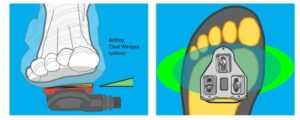
Shims should be used almost exclusively to address a leg length inequality or rarely for a Q-factor (stance width) issue when all other options fail Tailored to Individual Anatomy: Embrace the concept of customization to address individual anatomical differences. Explore how wedges allow cyclists to tailor their footwear to unique biomechanical variations and distinct foot structures.
How to Effectively Use Cycling Shoe Wedges:
- Professional Bike Fit: Begin your journey by investing in a professional bike fit. Certified bike fitters can assess your biomechanics, identify misalignments, and recommend the ideal wedge angle for your specific requirements. Ensuring that your bike fitter has the requisite knowledge to assess the foot is paramount. I would always recommend looking for someone with a professional health degree or lots of experience and a degree in human physiology.
- Gradual Implementation: Implementing wedges can be a gradual process if you are doing so without the advice of a fitter. Start with a modest wedge angle and progressively increase it as your body adapts. Overestimating your need for wedging can lead to discomfort, so a gradual approach is essential.
- Regular Monitoring and Adjustments: Regularly monitor your pedal stroke and address any discomfort or alignment changes promptly. Periodic check-ins with a bike fitter ensure that your wedges continue to align with your evolving cycling goals or when your body’s biomechanics change for better or worse.
Please check out our Toronto Bike Fits website for more information and to book a consultation if you are interested in custom cycling insoles and/or a bike fit.


